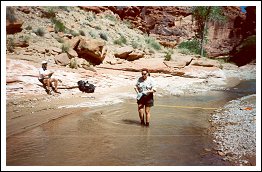|
The Total Maximum Daily Load (TMDL) Program is designed to help an impaired stream or lake meet its water quality standards and support its designated uses, such as protection of aquatic life, drinking water, and fish consumption. Section 303(d) of the Clean Water Act established authority for the TMDL Program and guides states on how to develop these plans for waters that do not meet water quality standards.
About the Program
 What is a TMDL? What is a TMDL?
A TMDL is the Total Maximum Daily Load (amount) of a water quality parameter which can be carried by a surface waterbody, on a daily basis, without causing an exceedance of surface water quality standards. TMDL calculations are made for waters listed as impaired on the state's 303(d) List. Every two years, states submit a list of impaired waters and a schedule to establish TMDLs to the U.S. EPA. The U.S. EPA reviews and approves the 303(d) Lists and schedules.
Who Completes a TMDL?
State water quality agencies are usually responsible for implementing the TMDL process. The U.S. EPA reviews and approves TMDLs. If the U.S. EPA disapproves a TMDL, it is required to establish the TMDL. Stakeholders (land owners, governmental agencies, special interest groups, etc.) can assist ADEQ in TMDL development.
How is a TMDL Calculated?
A TMDL is the sum of the load allocations (LAs) plus the sum of the wasteload allocations (WLAs) plus a margin of safety (MOS):

Load allocations include nonpoint source pollutant contributions, like loads from natural background and runoff from fields, streets, range, or forest land. Wasteload allocations include point source contributions like the loads from sewage treatment plant discharge and adit discharge. Load allocations and wasteload allocations are based on historic and recent water quality measurements and other environmental information.
Water quality monitoring initiated for the purpose of TMDL calculation is designed to identify the source and load of each pollutant and the critical condition(s) for loading. Critical conditions are often climactic (i.e., rainfall, snow), hydrologic (ie., high flows, low flows), and/or event-based (discharge, spills).
Load allocations, based on concentration and flow, and the TMDL calculation are derived using validated and broadly accepted statistical and/or modeling approaches. The margin of safety included in the TMDL usually includes "implicit" and "explicit" components. The implicit margin of safety includes conservative approaches to sampling and conservative assumptions made during load calculation. The explicit margin of safety takes into account a lack of knowledge concerning flow limitations and water quality.
What Happens After a TMDL is Calculated?
Once a TMDL is calculated, necessary load reductions are determined by comparing the TMDL to the total measured or modeled load on a source-by-source basis. An implementation plan, which includes effectiveness monitoring is then compiled.
Supporting information is synthesized into a draft report which is released to the public for a 30-day comment period, as noticed in a paper local to the community where the TMDL applies. After public comments are addressed and appropriate changes are made to the draft report, the draft report is submitted to the Arizona Administrative Register for a 45-day public comment period. Once again, comments are addressed and the report is finalized. A letter requesting approval of the TMDL is then sent to the U.S. EPA.
What Becomes of the TMDL?
A TMDL can be thought of as a Water Quality Improvement Plan. The source(s) of loading and critical condition(s) causing loading are identified through the TMDL process. As a result of this, stakeholders have the information necessary to make decisions which will result in the reduction or elimination of loading on a source-by-source basis. ADEQ will work with stakeholders to identify economically viable and effective ways to implement improvements.
See Also:
What is Effectiveness Monitoring?
Effectiveness monitoring determines the success of implementing Best Management Practices, permit limits, or other mitigation actions within a watershed. This includes monitoring to determine effectiveness of the TMDL strategy implementation. Baseline monitoring is needed prior to implementation to determine natural concentration and variation in the parameter of concern and to allow a statistically-based assessment of effectiveness.
Back to the top of the page
Arizona's Total Maximum Daily Load (TMDL) Program - History and Current Status
To view the most updated information on the TMDL Program Status, visit our new website at TMDL Status.
Back to the top of the page
Special Studies
Back to the top of the page
|